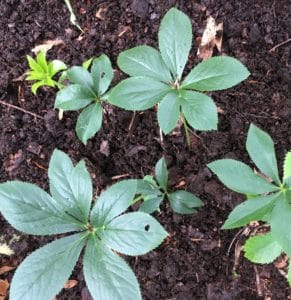Hello fellow readers, “Is fall a good time to mulch,” asked John of Washington, NJ. I think so, mainly because there’s much to do in the garden when spring arrives. And for me, the madness of the season speedily unfolds. Like most springs, mulching didn’t happen this spring despite my best intentions. Why not consider leaf mold, which may be better than wood mulch?

While visiting a new client nearby, my friend and design colleague Marty Carson suggested leaf mold would be a far better mulch.
A 101 on Wood Mulch
We’ve discussed the detriments of generic wood mulches and dyed mulches, which are often made from construction debris containing pressure-treated wood chock full of chemicals. Hence one reason why hemlock mulch, when made from local fallen trees, is my preference. Recently I was chatting with a friend and design colleague while visiting a client nearby who had just put hemlock mulch around their perennial garden. Marty suggested leaf mold would be far better, adding that wood chips steal nitrogen from the soil much needed by plants. So, I put on my research cap and learned fresh wood, especially sawdust, a no-no around plants, is the culprit of nitrogen theft far more so than aged wood such as naturally aged hemlock mulch. By the way, not all hemlock mulch sold is aged. Aged hemlock mulch is a pleasing deep burgundy-brown, while fresh hemlock mulch, not ideal, is reddish.
How to make leaf mold
Leaf mold is composted leaves packed with minerals. When added to your garden, they’ll feed earthworms and beneficial microbes; mixed in, they’ll lighten clay soils, and used as a mulch, they’ll help retain moisture and suppress weeds. You can make leaf mold by simply raking leaves into a big pile and letting them decompose. If shredded, which is easy to do by running over them a few times with the lawnmower before raking them up, they’ll decompose faster. After one to three years, your leaves will break down to a rich, earthy-smelling black material like compost. There is a technique to make leaf mold in plastic bags punched with holes, adding water to moisten and a scoop of soil, which accelerates the process to six to twelve months.
The benefits of mulching with leaf mold
John’s question has inspired me to lay down two to three inches of leaf mold this fall after the perennials are dormant. That way, over the winter, the nutrients can sink into the soil to nourish roots, which remain active all winter, absorbing nutrients for next year’s growth. As with any mulch, I’ll be sure to keep it away from the stems or trunks of plants to prevent rot, disease, or critter damage. Come spring, the leaf mold will serve its role of suppressing weeds, and I’ll be well ahead of the game. Humm, we’ll see… Garden Dilemmas? AskMaryStone@gmail.com (and now on your favorite Podcast App.)
You’ll enjoy Episode 5 of the Garden Dilemmas Podcast featuring Vitamin Packed Leaf Confetti
It seems only fitting I began my leaf mold mulching below hellebores gifted from Marty’s garden. They already look happy :^)
Column updated October 22, 2022





Is there any good reasons why you couldn’t distribute the freshly shredded leaves right into the plant beds? I don’t have an area for composting at the moment.
Hello Dan, Great question! As long as you shred them and don’t apply them too thickly, which could inhibit good water flow or trap too much water, you should be good. And, it is a great way to use the confetti of nutrients! Thanks for asking and for reading my column, Mary